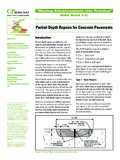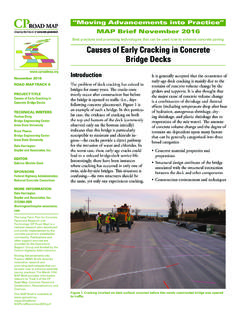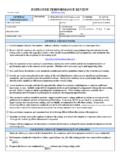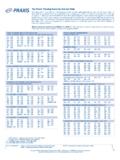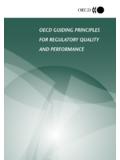Transcription of “Moving Advancements into Practice” MAP Brief …
1 developing a Quality Assurance Program for Implementing Performance Engineered Mixtures for Concrete PavementsJuly 2017 ROAD MAP TRACK 1 PROJECT TITLE Performance Engineered Mixtures for Concrete PavementsTECHNICAL WRITERSTom Cackler (lead) Mike Praul, FHWAR ichard Duval, FHWA EDITOR Sabrina Shields-Cook SPONSORS Federal Highway Administration National Concrete Consortium MORE INFORMATION Dale Harrington Snyder and Associates, Inc. (515)964-2020 Moving Advancements into Practice Best practices and promising technologies that can be used now to enhance concrete pavingThe Long-Term Plan for Concrete Pavement Research and Technology (CP Road Map) is a national research plan developed and jointly implemented by the concrete pavement stakeholder community.
2 Publications and other support services are provided by the Operations Support Group and funded by the Federal Highway Advancements into Practice (MAP) Briefs describe innovative research and promising technologies that can be used now to enhance concrete paving practices. The July 2017 MAP Brief provides information relevant to Track 1 of the CP Road Map: Materials and Mixes for Concrete MAP Brief is available at Brief July Circular 137 defines Quality Assur-ance as all those planned and systematic actions necessary to provide confidence that a product or facility will perform satisfactorily in service.
3 The Quality Assurance Program (QAP) for Performance Engineered Mixtures (PEM) for Concrete Pavements represents a system of individual and shared responsi-bilities that needs to be understood by the agency and contractor. This tech Brief is the second of a two part series on PEM specifica-tions and implementation. The April 2017 CP Road Map MAP Brief Performance Engineered Mixtures (PEM) for Concrete Pavement presented an overview of the PEM specification requirements. The CP Road Map MAP Brief and the AASHTO standard of practice PP 84-17 give details on the PEM specification requirements.
4 This tech Brief will overview QAP requirements specifically related to PEM, which are a subset of the overall QAP requirements for a overview of the QAP elements related to PEM is shown in Table 1. It consists of those activities the owner agency does as part of their acceptance responsibilities and also those activities that the contractor is respon-sible for (Quality Control, QC) to ensure the product meets the contract requirements. Table 1 also summarizes the critical mixture performance requirements and implementa-tion options. More detail is provided in the CP Road Map MAP Brief Performance Engineered Mixtures (PEM) for Concrete Pavements.
5 BackgroundHistorically, agencies have relied too much on 28-day strength of a concrete mixture as a quality indicator. The traditional mindset has been that if the 28-day strength meets the specification requirements, it was good concrete; strength was used as a quasi-indi-cator of durability. The concrete community was hampered by the lack of tests that were both indicators of concrete quality and those that could be done during production so that changes could be detected and corrected as needed while the project was still under construction. New TestsRecently, there have been significant ad-vancement in testing technologies that measure engineering properties important for good performance of the concrete pave-ment.
6 With these scientific Advancements , agencies and contractors now have the abil-ity to effectively monitor their production in real-time and adjust as needed to produce the desired level of quality. These new tests, particularly when used in conjunction with a performance specification and QAP, set the stage for significant Advancements in pavement performance. Figure 1 (page 4) shows several of the tests used in the PEM Specification: surface resistivity, calorimetry, and Super Air Meter (SAM).AASHTO PP-84-17 Standard Practice for developing Performance Engineered Concrete Pavement Mixtures The PEM specification is a leap forward for the concrete community.
7 It incorporates measuring the critical properties identified in Table 1 into a specification framework (Table 2). The premise behind the specifica-tion is to target the mix-design testing and acceptance testing towards those tests that are indicative of concrete quality and that will address known failure mechanisms. The specification removes some prescriptive specification elements, such as minimum or CP Road MAP Brief July 2017CP Road MAP Brief July 201723 Quality Assurance Program (QAP) for Performance Engineered MixturesAgency AcceptanceContractor Quality Control PlanQAP ElementsQualify contractors & labs and calibrate plantsQualify personnelIndependent assuranceDispute resolutionMeasure and evaluate the quality of the final product (inspection)
8 Determine final payment of completed workPre-ConstructionDuring ConstructionAssess personnel proficiency & equipmentSampling & testingMaterial observationsConstruction observationsAcceptance testingEquipment selectionLab qualification and plant calibrationPersonnel testingMaterial selection and mixture proportion-ingOverview of QAP requirements specific to PEMPer agency requirementsPer agency requirementsPer agency requirementsPer agency requirementsMixture qualificationPer agency requirements*Consistent with agency decision on 6 critical parametersPer contract specsPer contract specsPer contract specsPer contract specsMixture verificationAgency (mixture acceptance) Contractor (mixture design and production)Evaluate contractor's mixture proportionsMonitor implement-ation of contractor's QC planAir, strength, w/cm or F, %SCM or CaOXYS ubmit mixture design for SHA approval**Monitor early age mixture properties to ensure mixture produced is consistent with design and production process is uniform*Varies depending on choice of prescriptive or performance options selected**Testing targets, frequency, and action limits (minimum QC testing.)
9 Unit weight, air, w/cm, F, strength)Purpose of the 6 Critical Performance Engineered Mixture PropertiesPEM parametersAggregate stabilityTransport propertiesPaste durabilityShrinkageStrengthWorkabilityPu rpose of associated tests of requirementsAggregate durability including alkali-aggregate reactions and D-crackingMinimize the passage of water and aggressive fluids into the concreteResistance to freeze-thaw damage and chemical attachReduce moisture warping and crackingEnsure structural design requirement is obtainedEnsure mixture consolidates with proper operation of paver and holds an edgeApplicabilityNationallyNationallyMor e critical where deicing materials are used and freezing is commonMore critical in dry locationsNationallyNationallyImplementat ion optionsStandard aggregate screening testsPrescriptive or performancePrescriptive or performancePrescriptive or performanceStandard concrete strength testsBox or V-Kelly testsRefer to Table 2 for specific AASHTO or ASTM Test and Property MeasuredPP 84-17 SectionPropertySpecified testSpecified valueMixture qualifica-tionAccept-anceSelection detailsSpecial notes
10 Concrete StrengthT 97600 psiYe sYe sChoose either or both StrengthT 223500 psiYe sYe s Reducing unwanted slab warping and cracking due to shrinkage (if cracking is a concern) of Paste 25%Ye sNoChoose only one Volume ChangeASTM C157420 At 28 daysYe Volume ChangeASTM C157360, 420, 480 At 91 daysYe sNo ShrinkageT 334 Crack freeAt 180 daysYe sNo ShrinkageTP 363-17 (Dual Ring) < 60% 'rAt 7 daysYe of CrackingAppendix X15, 20, 50%As specifiedYe sNo CommentaryQuality Control Check NoYe sVariation controlled with mixture proportion observation or F factor and porosity Durability of hydrated cement paste for freeze-thaw Ratio Ye sYe sChoose Either or Air ContentT 152, T 196, TP 1185 to 8%Ye sYe sChoose only one Air Content/SAMT 152, T 196, TP 118 4% air.
